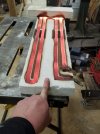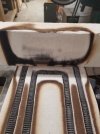I have used some Ceramic Fibre Board in HT ovens. Mainly because it seemed a lazy way to do things. I have not grooved it for elements though.
I first used the board, 1" thick, for the roof and backed it up with 2” Calcium Silicate board. It meant that I could bridge a full 9” width, which would not have been easy with 9” IFBs, enabling me to build a quick-and-dirty sword-length (42") oven without needing to cut bricks. The door used the same construction and for the same reason. Prior to that oven, I had built 3 smaller ones using all IFBs. I have since built 3 more ovens and used 2" Ceramic Fibre Board for the doors. Everything else is IFBs.
The floor used IFBs because ripping up ceramic fibres while putting stuff in and out seemed like a potential health hazard and I don't have the skill/experience to be sure I will not rip the floor up in use. The walls were also IFBs because the easiest way to cut grooves for the elements, in my experience, is to use a router. Routing board seemed unnecessarily hazardous in terms of creating airborne fibres. I do not have the equipment to capture and remove 100% of the dust generated when routing IFBs and fibres seemed much more likely to pose a long-term hazard.
I tried a porcelain floor tile, cut with a wet diamond tile saw, as a floor liner on the next (IFB) oven I built, just to see if it would hold up well enough to use to protect a Fibre board floor on future builds. It was not a great success. It survived a couple of heat cycles before cracking longitudinally, It still offered pretty good floor protection at that point but I don't know how well it stood up to further use or whether the new owner kept it in.





